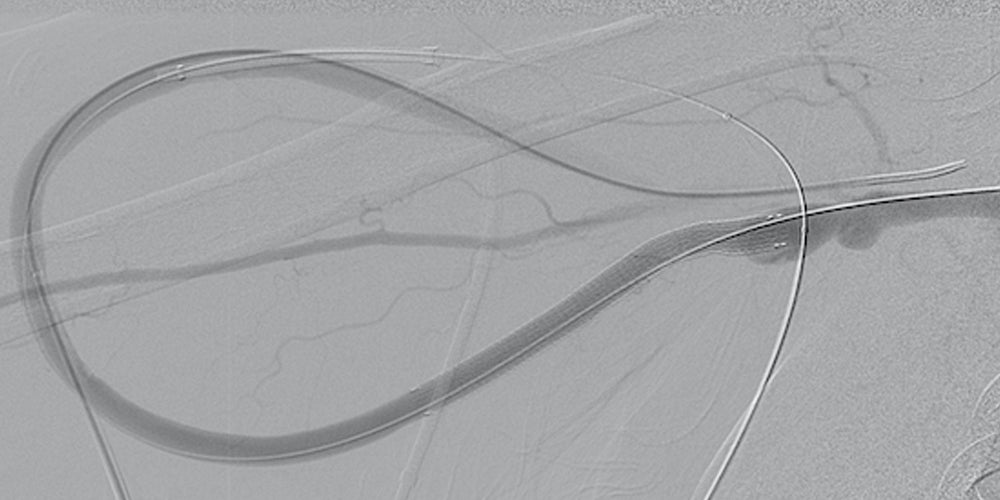Arteriovenous (AV) access grafts that have thrombosed are often associated with worse outcomes than those that are stenosed1
- The 2019 KDOQI guidelines for vascular access specify a target goal of ≤ three interventions annually to maintain access2:
- In support of achieving this goal, KDOQI recommends stent grafts in preference to angioplasty alone for recurrent thrombotic AV access lesions.
There are a limited number of randomized trials to help guide evidence-based treatment decisions for patients with thrombosed grafts
- In the Gore REVISE Clinical Study, 43% of patients in the GORE® VIABAHN® Endoprosthesis with PROPATEN Bioactive Surface* arm of the study enrolled with a thrombosed graft.1
The VIABAHN® Device has proven success when treating thrombosed grafts1
Proven patency
- Exceeded KDOQI minimum guidelines for 3-month circuit primary patency for thrombotic patients (48%) whereas percutaneous transluminal angioplasty (PTA) did not (39%).1,2
- Increased primary patency in thrombosed grafts of both the target lesion and the circuit by ~50% when compared to PTA at 6 months.1
Fewer reinterventions
- Lowered the mean number of interventions over 2 years by 40% in thrombosed grafts.3
* As used by Gore, PROPATEN Bioactive Surface refers to Gore’s proprietary CBAS® Heparin Surface.
- Vesely T, DaVanzo W, Behrend T, Dwyer A, Aruny J. Balloon angioplasty versus Viabahn stent graft for treatment of failing or thrombosed prosthetic hemodialysis grafts. Journal of Vascular Surgery 2016;64(5):1400-1410.e1. http://www.sciencedirect.com/science/article/pii/S0741521416301756
- Lok CE, Huber TS, Lee T, et al; KDOQI Vascular Access Guideline Work Group. KDOQI Clinical Practice Guideline for Vascular Access: 2019 update. American Journal of Kidney Diseases 2020;75(4)Supplement 2:S1-S164.
- Mohr BA, Sheen AL, Roy-Chaudhury P, Schultz SR, Aruny JE; REVISE Investigators. Clinical and economic benefits of stent grafts in dysfunctional and thrombosed hemodialysis access graft circuits in the REVISE Randomized Trial. Journal of Vascular & Interventional Radiology 2019;30(2):203-211.e4.

Refer to Instructions for Use at eifu.goremedical.com for a complete description of all applicable indications, warnings, precautions and contraindications for the markets where this product is available. RXOnly
INDICATIONS FOR USE IN EUROPE: The GORE® VIABAHN® Endoprosthesis with PROPATEN Bioactive Surface is indicated for the treatment of:
- de novo or restenotic lesions in the iliac arteries
- de novo or restenotic lesions in the superficial femoral artery and proximal popliteal artery
- in-stent restenotic lesions in the superficial femoral artery and proximal popliteal artery
- stenosis or thrombotic occlusion at the venous anastomosis of synthetic arteriovenous (AV) access grafts and in the venous outflow of dialysis access circuits, including the central veins
- popliteal artery aneurysms and isolated visceral artery aneurysms
- traumatic or iatrogenic vessel injuries in arteries that are located in the chest cavity, abdominal cavity, or pelvis (except for aorta, coronary, innominate, carotid, vertebral, and pulmonary arteries)
CONTRAINDICATIONS:
- Non-compliant lesions where full expansion of an angioplasty balloon catheter was not achieved during pre-dilatation, or where lesions cannot be dilated sufficiently to allow passage of the delivery system.
- Do not use the GORE® VIABAHN® Endoprosthesis with PROPATEN Bioactive Surface in patients with known hypersensitivity to heparin, including those patients who have had a previous incident of Heparin-Induced Thrombocytopenia (HIT) type II.
Product may not be available in all countries. Please check with your Gore representative for availability.

